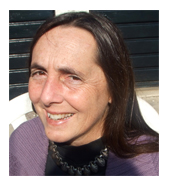Papa Christo Talks Shop
- Details
- Category: Interviews
- Published on Tuesday, 03 August 2010 22:08
- Written by Dianne Lawrence
Adorning the walls of the popular Papa Cristo’s Greek Restaurant are pictures from the 1948 grand opening of what was then just a simple Greek market.
 Sam Chrys opened C & K Importing Company, with the intention of bringing the foods and wines of Greece to Los Angeles. In 1968, Sam’s son and now the current owner, Chrys Chrys, purchased the business from his father to carry on the legacy and continues to import fine products from Greece like meats, seasonings, cheeses, olive oils, and other culturally true products.
Sam Chrys opened C & K Importing Company, with the intention of bringing the foods and wines of Greece to Los Angeles. In 1968, Sam’s son and now the current owner, Chrys Chrys, purchased the business from his father to carry on the legacy and continues to import fine products from Greece like meats, seasonings, cheeses, olive oils, and other culturally true products.
In 1985, Chrys wanted to create the feeling of the famous Greek taverna in the middle of the wholesale meat market in Athens. He bought the adjacent property, and opened a small kitchen with 12 seats. Since then he has purchased the 2 buildings on either side and opened a dining room with seating capacity for 100 and a delightful sunny patio/garden. His ability to create old world hospitality, that feeling of welcome and comfort, along with incredibly delicious traditional Greek food, makes Papa Christo’s one of L.A.’s premier Greek restaurants and a favored destination. It’s reputation extends as far as the east coast and Greece itself.
Running A Medical Marijuana Collective
- Details
- Category: Interviews
- Published on Sunday, 04 April 2010 04:29
- Written by Dianne Lawrence
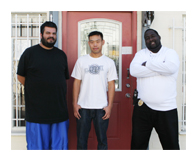
Interview with Daniel Sung, Director of LA Wonderland Caregivers
A Little Background: In November of 1996, California voters passed the Compassionate Use Act of 1996 or Proposition 215 with 55.6% of the vote. It allowed patients to use marijuana to alleviate the symptoms of a variety of ailments from cancer and Aids to sleeplessness and chronic pain.
Interview with Laura Meyers
- Details
- Category: Interviews
- Published on Wednesday, 03 February 2010 22:16
- Written by Dianne Lawrence
If you have participated in our community in any meaningful way then you probably know Laura Meyers.
Noted for her prodigious knowledge of all things related to local development, Laura is recognized as a fair and steady voice at meetings she attends or chairs, as well as for her tendency to be a little wonkish with the details. But you can hardly blame her. She has been at it for a long time and knows her stuff.
Ms. Meyers has held the position of Chair of the Zoning and Planning Committee on the United Neighborhoods Neighborhood Council (UNNC) since 2003 and has also been sitting on one of the project area advisory committees of the California Redevelopment Agency (CRA) for 20 years. Her involvement with community planning issues began in 1983 as one of the founding members of the West Adams Heritage Foundation. WAHA was originally established for historic preservation advocacy but within a few years it soon became apparent that preservation issues went hand in glove with zoning and development.
Anthony Nicholas Remembers Rosa Parks
- Details
- Category: Leaders, Activists
- Published on Wednesday, 24 February 2016 15:29
- Written by World Tribune
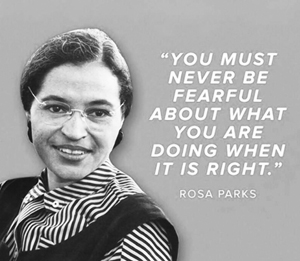 This article is reprinted with permission from the World Tribune. For more information on that publication, visit www.sgi-usa.org.
This article is reprinted with permission from the World Tribune. For more information on that publication, visit www.sgi-usa.org.Tony Nicholas, director of the Tom Bradley Family Source Center in Los Angeles, spoke on Oct. 4 at the SGI-USA World Culture Center in Santa Monica, California. Mr. Nicholas shared his recollections of the two meetings between his dear family friend Rosa Parks and SGI President Ikeda. The World Tribune sat down with him to discuss those encounters as well as other memories from his extraordinary life.
Nicholas: When I was 8 years old my mother remarried a lawyer named Leo Branton Jr. He was the first African American entertainment attorney in the 1950s. His clients included Nat King Cole, Dorothy Dandridge, Lena Horne, Miles Davis and Richard Pryor.
Later, he got more involved in the U.S. Civil Rights Movement and traveled throughout the South. When Dr. Martin Luther King Jr. and other civil rights leaders would get arrested, my stepfather would be the one to get them out. I was able to travel with him and meet both Dr. King and Rosa Parks.
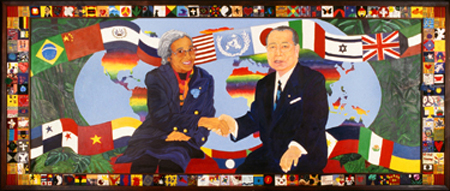 WT: Rosa Parks is revered throughout the world for refusing to give up her bus seat to a white passenger in Montgomery, Alabama, on Dec. 1, 1955. Mrs. Parks’ resistance and the Montgomery Bus Boycott that followed became important catalysts for the Civil Rights Movement. We understand that Mrs. Parks was a close family friend. What was she like?
WT: Rosa Parks is revered throughout the world for refusing to give up her bus seat to a white passenger in Montgomery, Alabama, on Dec. 1, 1955. Mrs. Parks’ resistance and the Montgomery Bus Boycott that followed became important catalysts for the Civil Rights Movement. We understand that Mrs. Parks was a close family friend. What was she like?Nicholas: Although presidents, kings and queens held Mrs. Parks in high esteem, and the people saw her as an icon, she remained such a humble woman. I learned from her to treat all people with compassion, and it’s something that I’ve carried into my own life as the director of the Tom Bradley Family Source Center. Every person who walks into my community center, whether it be the mayor of the city or a homeless individual, will get the same treatment. I learned this from Mrs. Parks.
Years later, my stepfather invited Mrs. Parks to stay in Los Angeles for six months out of the year to escape the cold in Detroit. So for 10 years, Mrs. Parks stayed at my family’s home in Los Angeles during the cold months. Every time I would go home, there was Rosa Parks, sitting on the couch drinking a cup of tea.
WT: What is your favorite memory of her?
Nicholas: I have many, but one time, when my daughter Nicole was in the first grade, we came over to my parents’ house to watch football. Nicole had a history report due, and she had to learn this poem about Rosa Parks. I went into the kitchen for a glass of water and saw Mrs. Parks patiently teaching my daughter a poem about herself. I’ll never forget that moment.
WT: You introduced Mrs. Parks to the SGI and President Ikeda. How did that come about?
Nicholas: My longtime friend Joe Perez first taught me about the philosophy and history of the SGI and Dr. Ikeda. He shared that Dr. Ikeda was an admirer of Dr. King and Mrs. Parks for their fight for the civil rights of African Americans.
On Jan. 30, 1993, Joe and I brought Mrs. Parks to the [former] campus of Soka University of America [in Calabasas, California] to meet Dr. Ikeda.
WT: What was your impression of their first meeting?
Nicholas: I will never forget it. When Dr. Ikeda arrived, he very humbly greeted each person. The first thing that struck me was his presence. Although he’s not a tall man, I felt like I was with a giant! Then, the two sat down and began to talk as if they had been friends for decades. I thought: My God, these two icons, who are so admired all over the world, are coming together. What an inspirational moment for the whole world. They talked about world peace and the youth of the world. They wanted to ensure that we stop all the violence and come together as people.
WT: We understand that many of those who knew Mrs. Parks were surprised that she accepted President Ikeda’s invitation to visit Japan, given that she had never traveled farther than America’s immediate neighbors.
Nicholas: She didn’t like t o travel overseas, but she felt so humbled by the fact that Dr. Ikeda had invited her and was going to bestow her with an honorary doctorate [from Soka University, which he founded]. I accompanied Mrs. Parks to Japan in May 1994.
WT: What was the trip like?
Nicholas: I will never forget the moment when we went to Soka University, where Mrs. Parks was to receive an honorary doctorate degree. We walked up to the stage of the auditorium, and the faculty was there with us. I looked around and thought it was just us.
Lo and behold, the curtains opened and there were thousands of Soka University students. We had no idea they were there because they were so quiet; I was amazed by that. Then they all stood up, crossed their arms and linked hands, as we did in the Civil Rights Movement, and started singing “We Shall Overcome” in English. What a moving moment; I cried and Mrs. Parks cried. Everyone was so moved.
Later, as we got in our cars and left the campus, all the students were lined up on both sides of the road. As the car passed, the students bowed. Their deep reverence and respect is something I attribute to the teachings of Dr. Ikeda. I will never forget that. We were treated like royalty. It was certainly quite an experience.
WT: In the book Talking Pictures: People Speak About the Photographs That Speak to Them, Rosa Parks chose a photograph from her meeting with President Ikeda in 1993 as one of the most important moments in her life.
Nicholas: When I would see Mrs. Parks toward the end of her life, of all her encounters, she would recall her encounters with Dr. Ikeda. She talked so fondly of Dr. Ikeda and the impression he left on her. She said he was unlike any other leader she had met. That was quite something. I certainly feel the same way about the effect he had on me.
WT: As someone who has also committed your life to serving others, what message would you like to impart to today’s youth?
Nicholas: I’ve had the honor of knowing and working with Rosa Parks, Dr. King and meeting Dr. Ikeda. These icons were willing to give their lives for the cause of freedom and peace. Young people should look within themselves and understand the shoulders that we are all standing on. We have got to be more tolerant, and we have got to understand the importance of healing and caring in a way that makes life better for us all.
WT: In an essay President Ikeda wrote about Mrs. Parks, he said: “Mrs. Parks related that it was her mother who raised her to be strong: ‘My mother taught me self-respect. She always insisted, There is no law that people have to suffer.’ ” Would you like to share any parting thoughts about your own mother?
Nicholas: My biological father and my stepfather were two great men, icons. But who was the driving force behind their careers? It was my mother. I hold women in such high esteem because of my mother, my wife, my two daughters and my grandchildren. I’m fearful of the kind of world that I’m going to leave behind for them. I believe we’ve got to do all that we can for world peace. We’ve got to come together.
Preservationista Laura Meyers Wins Coveted Martin Weil Award
- Details
- Category: Leaders, Activists
- Published on Thursday, 04 July 2013 12:27
- Written by D.V. Lawrence
Laura Meyers is a dedicated, effective and passionate preserver of West Adams architectural heritage.
On May 5 at the Annual West Adams Heritage Association (WAHA) Preservation Brunch, she was recognized for her untiring efforts to defend against the encroachment of unenlightened development, to maintain the historic, architectural integrity in West Adams and to keep ongoing awareness of these issues front and center in the community by being awarded the Martin Weil Award. Martin Weil, who passed in 2009, was a local luminary in the world of preservation. Among his numerous accomplishments, he was a founding member of the Los Angeles Conservancy and a member of WAHA. WAHA created the award to honor Weil, making him the first recipient while he was still alive. It now honors the local heroes and heroines of preservation.
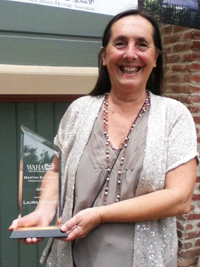 Laura has been a prime instigator and/or partner in getting 21 local buildings awarded Historical Cultural Monument (HCM) status. The South Seas House on Arlington below the 10 Freeway was referred to as the Witch’s House for many years because of its crumbling roof and ragged peaked gables and dilapidated exterior. It was headed for demolition before Laura and others stepped in, found the money and team for construction and began to plan the rehab. Councilman Nate Holden and members of the Council District 10 office stepped up, found over a million dollars to help restore it, and the house opened as a community resource for Parks and Recreation in 2003.
Laura has been a prime instigator and/or partner in getting 21 local buildings awarded Historical Cultural Monument (HCM) status. The South Seas House on Arlington below the 10 Freeway was referred to as the Witch’s House for many years because of its crumbling roof and ragged peaked gables and dilapidated exterior. It was headed for demolition before Laura and others stepped in, found the money and team for construction and began to plan the rehab. Councilman Nate Holden and members of the Council District 10 office stepped up, found over a million dollars to help restore it, and the house opened as a community resource for Parks and Recreation in 2003.
Laura is especially interested in the rich African-American history embedded in almost every neighborhood in West Adams. She coordinated the research, writing and editing of WAHA’s “West Adams Landmarks of African- American History,” which tells the stories of nearly 150 local sites associated with black history and personages.
One of her most beloved projects is the annual Living History Tour which takes place in the Angelus Rosedale Cemetery, one of the oldest cemetaries in Los Angeles, located on Washington and Normandie. As one of the WAHA coordinators of the event, she is tasked with researching the historic people buried there, finding actors to play them and writing the monologues about their lives. Audiences hike through the beautiful cemetery as the tour guide points out special graveyard features while directing them to the various gravesites where costumed actors deliver their historic story. It is one of the favorite community events of the year.
To read more about the different Living History Tour events, CLICK HERE .
Keepin' It Clean
- Details
- Category: Leaders, Activists
- Published on Thursday, 20 June 2013 12:43
- Written by D.V. Lawrence
Longtime Western Heights resident Krishna McCain takes pride in the community he was raised in.
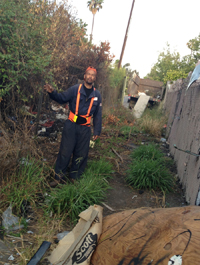
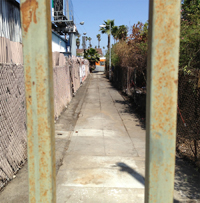
Often seen with a broom in hand he takes it upon himself to clean up forgotten pockets of his community. A neighborhood walkway, ignored by local residents after it had been gated, became overrun with debris and overgrowth, creating an eyesore and hazard. With support from local artists, LAFD Station 26 and some hired assistants, Krishna got it done. An ex-gang member, Krishna turned his life around and is now a member of the L.A.F.D. Emergency Response Team and an engaged community activist. TNN Salutes You!
Tony Nicholas of the Tom Bradley Family Source Center
- Details
- Category: Leaders, Activists
- Published on Tuesday, 30 April 2013 16:42
- Written by Chelsee Lowe
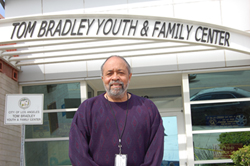 It’s fitting that Tony Nicholas shares his name with Saint Nicholas, the ancient, gift-giving bishop whom the folk character Santa Claus is based on. After 42 years in community service work, and over 60 years if you count his activism as a child and teenager, Tony is as close to a present-day Saint Nick as one might find.
It’s fitting that Tony Nicholas shares his name with Saint Nicholas, the ancient, gift-giving bishop whom the folk character Santa Claus is based on. After 42 years in community service work, and over 60 years if you count his activism as a child and teenager, Tony is as close to a present-day Saint Nick as one might find.
Lucky for us, he spreads his goodwill here in Mid-City as Director of the Tom Bradley Family Source Center on Pico Boulevard.
Shadowing Tony for just one hour at the center gives you a good idea as to why the community holds him in high esteem. Children pop into his office and ask for help with writing or multiplication homework, co-workers share jokes while scheduling the next day’s activities, and new faces are greeted with handshakes and smiles. People who come and go may be struggling, but at the center there’s a genuine sense of safety and peace.
After 14 years as director, Tony feels that the firestation-turned-community-center runs like a well-oiled machine. Staff members Andrea Solomon and Eddie Munoz help organize all programming and volunteers, and their most popular offerings include free after-school tutoring, affordable ESL classes and computer courses, and tax help. There’s also a bi-monthly vegan food giveaway that aids approximately 400 local households per event, thanks to donations made by Simpson’s co-creator and local philanthropist Sam Simon. Tony has also watched the community grow into a diverse neighborhood in the past years: “I’m really pleased at seeing different races coming together,” he said. “When you have diversity, as opposed to one group completely dominating, it’s great.”
Tony loves his job and is proud of the center’s contributions, but of course there are challenges, as there are in every business. “I don’t have enough space or staff to do all that I want to do. I wish I could feed 10,000 families. I wish could hold classes for hundreds of students. That’s the frustrating part. That’s the part of the job that hurts the most. But there are good days, too.”
If you ask Tony how he came to work in community service, he’ll tell you his path was well-paved by his father, mother, and stepfather. His father Fayard Nicholas, brother to Harold Nicholas and Dorothy Dandridge, was a renowned dancer and actor who’s success on the stage allowed the family a stable financial income and gave Tony the opportunity to travel abroad at a young age. Tony’s mother, Geraldine Nicholas Branton, was a passionate political activist; she married Civil Rights attorney Leo Branton, Jr.(Read TNN profile on our website in Featured Residents). Even as a tiny baby, Tony’s mother involved him in her activism. “Before I was born my mother wanted to buy a house on the Westside [of LA], but there was a covenant that said African Americans – called Negroes back then – could not buy west of Arlington. She was infuriated, so she looked for a house on Arlington. She ended up going one street east to Van Ness and bought a house with all cash. Then she immediately went down to City Hall and started picketing, and I was with her in a baby buggy. I was six months old. She held a sign that said “L.A. is unfair to Negroes.”
From then on, Tony’s political involvement never ceased. At the age of eleven he joined his mother and stepfather on Adlai Stevenson II’s presidential campaign, and the spirit at headquarters inspired him. “I saw the excitement, I saw the enthusiasm, and I thought, ‘This is great, I love this.’ We’d go out and get food and clothing for families in Mississippi. I had a chance to go down South, and I started seeing the conditions and how people were suffering. It really touched me; I wasn’t subjected to the racism or the poverty. I’ve been involved ever since, and I still have a passion for it.”
Tony continued his activism well past his teenage years. In 1984 he acted as statewide coordinator for Jesse Jackson’s presidential campaign, and in 1987 he spearheaded a national movement to fight against federal cuts that would wipe out community programs; he helped lead a march on the Federal Building with over 5,000 participants and organized a convention in Los Angeles with speakers like Maxine Waters and Jesse Jackson. “The theme was ‘Congress: Don’t Break Our Hearts,’” Tony shared. “And it worked. They didn’t cut the funds. I got telegrams from all over the country and they brought me down to City Hall. Tom Bradley presented a plaque to me that reads ‘Committed to Save Human Services.’ That was quite an honor.” Tony worked at a veteran’s council center for eight years before Councilman Nate Holden asked him to be director at a new community center in Mid-City.
“I’m 68 years old but I come to work every day with a smile and I leave every day with a smile,” Tony said. “Not too many people go to work and like what they do. These children have touched me, and I love helping the community. It is something that I’m so very lucky to have. I wish I could do it forever, but I can’t obviously.”
Tony is planning to retire this year, but he’s not completely set on it. “I’ve heard some things that I’m troubled about. There will probably be some cutbacks in funding that will affect this center. I may consider staying. I’m
not one to run away from a fight."
Photo by Dawn Kirkpatrick
Grace Santana of the Longwood Highland Neighborhood Watch
- Details
- Category: Leaders, Activists
- Published on Friday, 12 October 2012 13:49
- Written by Chelsee Lowe
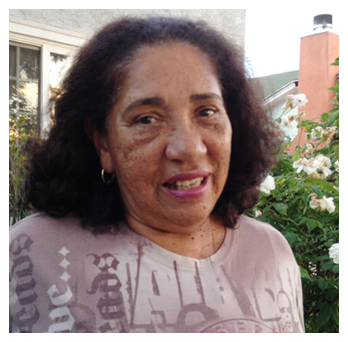 A stark void was left when long-time community activist Celia Bell left Longwood Avenue for Las Vegas, but lucky for the neighborhood Grace Santana was willing to step into her place. It’s been over one year since the humble Santana began hosting the monthly Longwood Highland Neighborhood Watch meetings, and the sense of community in the area continues to grow with her help.
A stark void was left when long-time community activist Celia Bell left Longwood Avenue for Las Vegas, but lucky for the neighborhood Grace Santana was willing to step into her place. It’s been over one year since the humble Santana began hosting the monthly Longwood Highland Neighborhood Watch meetings, and the sense of community in the area continues to grow with her help.
The Watch came into being after a series of robberies and assaults occurred in the area. “We started the meetings then,” Santana said. “We had to do something. We said let’s have a meeting, everybody get together, so everyone can look out for each other.”
Now Santana can name the residents of nearly every home on her street, and she feels a strong sense of responsibility for her neighbors’ well-being. She also knows that the area’s crime rate has fallen since the group formed.
“We want to make our neighborhood safe, that is my intention. After these meetings, I think we feel safe. The police drive passed here two or three times a week, sometimes twice a day. And now we know each other. You never know when you’ll need your neighbors.”
Santana hosts meetings in her own home on the last Tuesday night of every month. The number of attendees ranges between ten and twenty. “It’s not an obligation,” Santana says. “You have to understand that people work. People who come usually bring something, so everyone has a little dinner. It’s a neighbor get-together. It makes me happy.”
Ron Finley. Staying Active
- Details
- Category: Leaders, Activists
- Published on Friday, 05 October 2012 16:38
- Written by Chelsee Lowe

Last year The Neighborhood News spoke with community activist Ron Finley, co-founder of LA Green Grounds and urban gardener extraordinaire.
At the time, Finley was fighting the city of LA, which had written him a citation for planting an edible garden in the parkway in front of his house off of Exposition Boulevard. TNN caught up with Finley this week at Vees Cafe on Adams Boulevard to see what he’s been up to this past year.
TNN: Catch us up on the ordinance battle. You put up a petition on change.org, and got over 900 signatures. Then, the city backed down? Herb Wesson said that he backed you up in this situation.
RF: Yes, he did. Where it’s standing now, we’re in city hall. Me and Herb met, he gave us three meetings [with the city], and we’ve had two. We’re going to amend the ordinance to add edibles to it. We’ve sent them a list of what we think people should be able to grow in parkways. That’s going to affect all of Los Angeles.
TNN: We heard that you’ve recently been a part of the fight against tree removal in Inglewood; nearly 400 trees throughout South LA will be cut down to make way for the space shuttle Endeavor, which is headed to the California Science Center in Exposition Park.
RF: We think that’s insulting, and racist. [City officials] didn’t contact anyone in the community. They just went on with this and they’re taking out these mature trees. They’re talking about planting two trees for every tree that they take; they’re not planting trees, they’re planting saplings. It’s almost like the arborists have no idea what trees do to the air, to the pollution. They couldn’t do this in Beverly Hills. I’m tired of us being looked at as people who don’t care about their families or neighborhood. That’s what this shows us. It’s insulting that they would even do that without contacting us, without having a community meeting. It’s social racism.
TNN: Were you spearheading this fight, or were others involved?
RF: [Chuckles]. I’m not spearheading anything. It’s almost like, “Who wants to storm the castle?” Then everyone takes two steps back so it looks like you stepped forward.
TNN: And that’s you, the one stepping forward?
RF: Sometimes I feel like this. But this is my neighborhood, this is my city, this is the future. Our health is in turmoil. It’s a crisis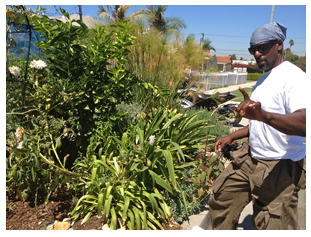 situation; somebody needs to pay attention to it. It’s almost by design, dumbing people down. That’s why we’re dealing with food issues. I work in food injustice. Drive down this street: there’s no place that you’re going to get an organic apple. I got tired of that, and that’s why I planted my own garden. I want people to plant their own food; stop waiting for people to do stuff for you, because you can see they’re not. Food is our medicine. Other than air, food and water is what you need.
situation; somebody needs to pay attention to it. It’s almost by design, dumbing people down. That’s why we’re dealing with food issues. I work in food injustice. Drive down this street: there’s no place that you’re going to get an organic apple. I got tired of that, and that’s why I planted my own garden. I want people to plant their own food; stop waiting for people to do stuff for you, because you can see they’re not. Food is our medicine. Other than air, food and water is what you need.
TNN: Do you see progress being made in our community?
RF: In certain things I do, but you wonder if it’s a dog and pony show. I feel pretty good about the parkway initiative. Wesson thanked us for bringing [the problem] to his attention. You’ve got this land and you’re asking people to use their water on it and maintain it for grass -- why? There’s no reason anyone in this country should be hungry. I sound like a do-gooder, but I’m not. But I try not to do anything if I’m not passionate about it. I don’t know how long I’m here, and I want to put a big ass dent in this place before I leave. We gotta get passion back.
visit lagreengrounds.org. You can also view his recent TED talk on the subject on YouTube.com.
Minimizing Conflict in Community Groups
- Details
- Category: Leaders, Activists
- Published on Monday, 28 February 2011 21:22
- Written by Michael Sonntag
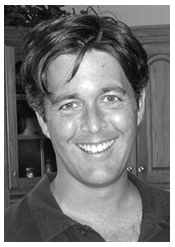 Concern: Whether it’s in my neighborhood’s association in Wellington Square, or a concern being addressed by MINC (Mid City Neighborhood Council), there are challenges to hearing differences of opinion. How do you keep people engaged and the process moving forward without collapsing into argument sessions? Getting bogged down in fights leaves people with bad feelings and results in fewer and fewer people wanting to become involved.
Concern: Whether it’s in my neighborhood’s association in Wellington Square, or a concern being addressed by MINC (Mid City Neighborhood Council), there are challenges to hearing differences of opinion. How do you keep people engaged and the process moving forward without collapsing into argument sessions? Getting bogged down in fights leaves people with bad feelings and results in fewer and fewer people wanting to become involved.
Solution: I think the first key is to make sure that as many lines of communication are kept open as possible. It is important that those who are affected or interested in the outcome are kept very informed. This means notifying people of meetings, decisions, suggestions, etc. at every step of the process, and keeping the forward momentum as open to the public as possible. Often the complaint you hear is “we didn’t know” - and the best way to sidestep that is to make sure you publish and post all the information. It doesn’t always mean people will see it - but if you can show them the attempt, it at least can help cool the fire. In my own neighborhood, we’ve found a lot of value in setting up a website - and posting all sorts of information on our blog, on Facebook, on Twitter, and via a Yahoo! group. It’s probably overkill - but it means that people can find and hear from us however they’d like to do so. And I constantly hear from people that are so grateful to be kept in the loop.
You also have to allow a chance for people to be heard through the process. It doesn’t mean that the committee needs to agree or follow the directive of every complaint or counter opinion. But I’ve seen more things scuttled by the fact that the committee just wasn’t really interested in listening to something counter to their thoughts. I often understand that committee members are tired and they’ve already hashed through the issues. But more good can be done by just listening to people and expressing sincere concern- than by anything else. People need to feel that their concerns are at least addressed in some way - even if they don’t like the eventual outcome. Organizations can often accomplish a lot more - and keep more people happy - if they just talk and listen a bit more.
Michael Sonntag sits on the executive board of the Wellington Square Improvement Association, as well as the Mid City Neighborhood Council as the Region 3 Representative.
More Articles...
Yesterday10
Week17
Month217
All964831
Currently are 5 guests and no members online
Kubik-Rubik Joomla! Extensions



